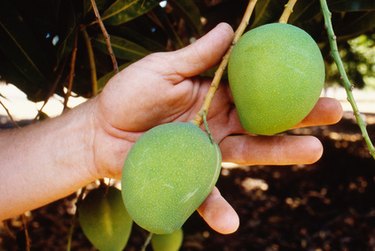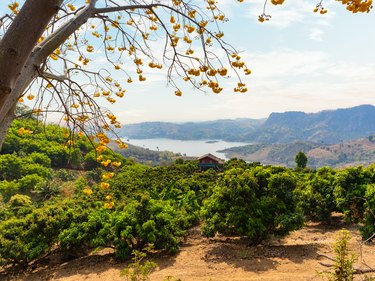
Native to India and Southeast Asia, mangoes (Mangifera indica) are among the world's most popular fruits. Though they are often pruned in cultivation, mango trees are large and are not suitable for small spaces. Grown in tropical and subtropical areas around the world, mango trees are hardy in U.S. Department of Agriculture plant hardiness zones 10b and 11.
Different Mango Varieties
Video of the Day
There are two main types of mangoes: Indian and Indochinese. You can often identify Indian mangoes because they tend to have more coloration than Indochinese mangoes. Different mangoes also grow at different rates. In fact, varieties are assigned a low, medium or high vigor rating, which can affect mango plant distance. The taproot of a mango tree can extend up to 20 feet into the soil, and feeder roots can be several feet long.
Video of the Day
A mango tree that is not pruned can grow up to 100 feet and have a canopy that is 35 feet wide. In cultivation, trees are often pruned to a smaller size to make it easier to maintain the trees and harvest the fruit. In this sense, mango trees with a low or medium vigor rating are easier to maintain. Dwarf mango trees are between 6 and 13 feet tall and can be grown in containers. The 'Nam Doc Mai' and 'Irwin' varieties are two that are recommended for containers.
Mango Tree Site Selection

Because it is a tropical fruit tree that cannot handle freezing temperatures, in the United States, mango trees are mainly grown in Hawaii, southern Florida and southern California. When planting a mango tree, it is vital to choose a location that receives a minimum of six hours of sunlight a day. Good drainage is also key for mango trees, which is why you should avoid planting them in sites that are prone to flooding after rain.
The distance between two mango trees should be 25 to 30 feet. You should keep the same distance between mango trees and buildings and power lines. On the other hand, you can leave just 12 to 15 feet of space between dwarf mango trees. You can also leave less space between mango trees that have a low or medium vigor rating and that you plan to prune. Gardeners should hire professionals to prune mango trees that are more than 25 feet tall, as it can be dangerous work.
Caring for Mango Trees
When first planted, mango trees should be watered every other day for a week. You can then reduce watering to once or twice a week. Maintain this frequency for several months. Young trees that are less than three years old should be watered weekly. Mature mango trees rarely need supplemental water.

You should fertilize mango trees with a formula that is rich in nitrogen. To avoid fertilizer burn, use organic fertilizers. The ideal soil pH for mangoes is between 5.5 and 7.5, so conduct a soil test and amend the soil accordingly. Because they are self-fertile, only one mango tree is needed to produce fruit.
- University of Florida IFAS Extension: Mango Growing in the Florida Home Landscape
- New York State Horticulture Study Guide for Youth: Mango
- National Mango Board: Meet a Mango Tree
- Texas A&M AgriLife Extension: Fruit & Nut Resources - Mango
- California Rare Fruit Growers: Mango
- University of Florida IFAS Extension: Mangifera Indica - Mango